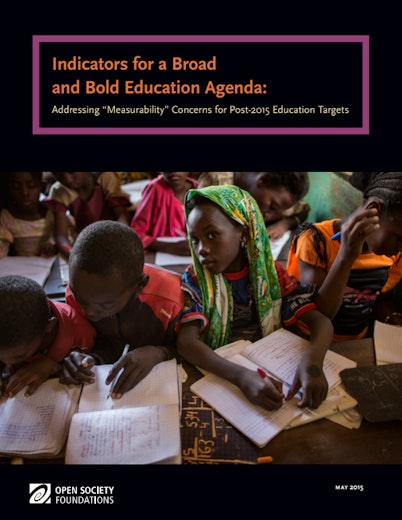Global Education Goals Shouldn’t Just Be a Numbers Game
By Dierdre Williams

In the year 2000, 164 governments pledged to provide quality basic education for all children, youth, and adults by the year 2015. The pledge was codified in six interrelated goals known as the Education for All (EFA) goals. Two of these six goals formed part of the Millennium Development Goals (MDGs)—eight goals adopted by UN member states in the year 2000 that aimed, among other things, to eradicate extreme poverty.
Since their establishment, the MDGs have resulted in tangible human development around the world, particularly in the areas of extreme poverty and hunger (Goal 1) and combating disease (Goal 6). Progress on many of the other goals, however, including those related to education, has been uneven.
For instance, global commitments to achieve universal primary education by 2015 (Goal 2) initially resulted in an 18 percent increase in primary enrollment globally between 1999 and 2009, with the most significant improvements occurring in sub-Saharan Africa. But this progress declined sharply in 2009.
In fact, none of the six EFA goals will have been achieved by the 2015 deadline. There are several reasons for this. The overall picture of progress masks deep disparities between and within countries in their efforts to achieve these goals. Marginalized groups—including the poor, rural residents, people with disabilities, girls, ethnic minorities, and people affected by conflict—are hard to reach and have been left behind.
Partly because of this, overall progress has actually resulted in a measure of greater inequity. Even where children were able to access schooling, 250 million children of primary school age who reached grade four were failing to learn the basics in reading as of 2013/14. An array of factors account for this shortfall: poorly trained teachers, shortages of textbooks and materials, and large class sizes—in some contexts averaging 146 pupils to one teacher.
The process of establishing goals to drive global development over the next 15 years is currently underway. The Sustainable Development Goals (SDGs) will encompass a wider range of issues than the current MDGs, including climate change, access to justice, and sustainable consumption and production. In addition to setting topline goals that convey the big aspirations of the global community, the process of developing new SDGs involves setting targets (to help measure action and inaction against timelines) and indicators (to monitor progress toward achieving the established targets).
The global community, including states and civil society, through a broadly democratic process, has formulated 10 targets relating to the proposed education SDG (Goal 4). The process of creating indicators relating to these targets is currently ongoing. Many of the targets are being criticized on the basis that they are not measurable, or quantifiable, and therefore not subject to systems of accountability.
Yet, even these harder-to-measure targets are central to achieving quality education. Economist Amyrta Sen has critiqued [PDF] the current MDGs, arguing that they narrowed the Millennium Declaration on which they were based by dispensing with anything that wasn’t immediately measurable. There is a similar risk of narrowing in the current SDGs process where some of the proposed targets are being deemed “not measurable” either because they lack specificity or because data for proposed measures are “currently unavailable.”
This raises an important question: how can we start valuing practices and outcomes of teaching and learning that are difficult to reduce to numbers?
The Open Society Foundations have selected three targets relating to the education SDG consistently referenced as “not measurable” and have commissioned papers proposing formulations of indicators that allow us to “measure the unmeasurable.” The three targets for which indicators have been developed relate to:
- determining what “relevant and effective learning outcomes” students completing primary and secondary education should achieve;
- identifying “knowledge, values, skills, and attitudes to establish sustainable and peaceful societies”; and
- securing “teachers and safe, inclusive, and effective learning environments.”
The indicator frameworks presented in these commissioned works reflect the authors’ diverse thinking, rather than consensus on any of the issues explored. The annex in the related synthesis report lays out the full text of the indicators and related targets proposed in the commissioned papers.
The proposed indicators highlight the crucial need to capture more holistic data that can convey the complexity and diversity of national systems. The possibilities presented in the commissioned papers and the synthesis report are intended as a resource for policymakers and advocacy groups as the process to settle the new SDGs unfolds.

Dierdre Williams is managing director of Open Society Network Grants at the Open Society Foundations.
